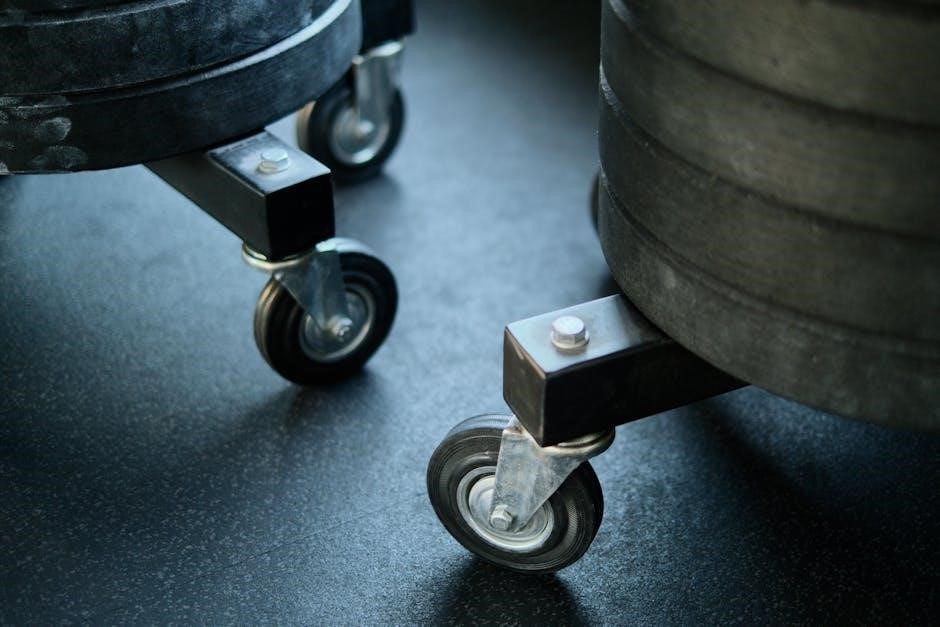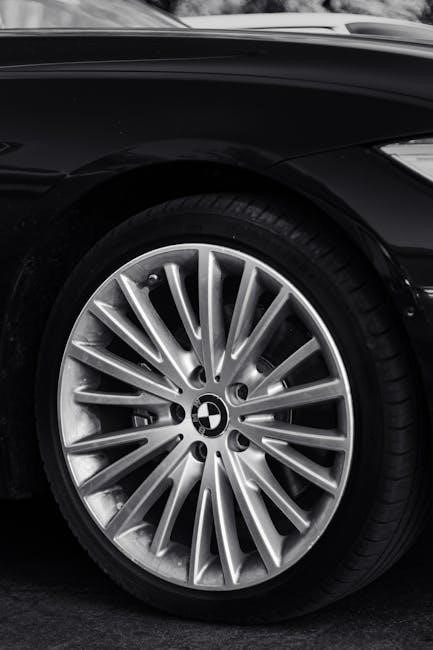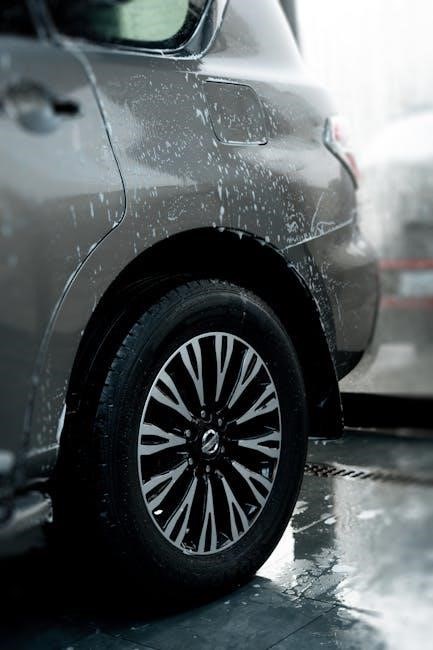Wheel weights are essential for balancing tires and wheels, ensuring smooth vehicle operation․ They counteract irregularities, prevent vibrations, and enhance ride comfort․ Properly installed, they optimize performance and safety․
1․1 What Are Wheel Weights?
Wheel weights are small, precisely measured devices attached to a vehicle’s rims to balance the wheel and tire assembly․ They are typically made of metal, zinc, or composite materials and are designed to counteract irregularities in the tire or wheel․ By adding weight to specific points on the rim, they ensure a smooth rotation of the wheel, eliminating vibrations and wobbles․ Properly installed wheel weights are essential for maintaining vehicle stability, improving ride comfort, and preventing uneven tire wear․ They are a critical component in achieving optimal wheel balance for safe and efficient driving․
1․2 Purpose of Wheel Weights
Wheel weights serve to balance the wheel and tire assembly, ensuring smooth rotation and eliminating vibrations․ Their primary purpose is to counteract uneven weight distribution, which can cause wobbling or shaking while driving․ Properly applied, they enhance vehicle stability, improve ride comfort, and prevent uneven tire wear․ Wheel weights are essential for maintaining optimal performance and safety, particularly at higher speeds․ By addressing imbalances, they contribute to better handling and reduced strain on suspension components, ensuring a safer and more enjoyable driving experience for all vehicle types․
1․3 Importance of Proper Wheel Weight Balance
Proper wheel weight balance is crucial for ensuring a smooth and safe driving experience․ Imbalanced wheels can lead to vibrations, uneven tire wear, and reduced vehicle stability, particularly at high speeds․ This imbalance can also increase the risk of tire failure and compromise handling, making it harder to control the vehicle․ Additionally, improper balancing puts extra strain on suspension components, leading to premature wear and potential mechanical failures․ Correct wheel weight balance enhances comfort, improves fuel efficiency, and extends the lifespan of tires and other critical vehicle parts, making it a vital maintenance task for all drivers․

Types of Wheel Weights
Wheel weights come in various forms, including adhesive, clip-on, and composite styles․ Each type offers unique benefits, ensuring proper balance and compatibility with different vehicles and rims․
2․1 Adhesive Wheel Weights
Adhesive wheel weights are small, precisely measured devices attached to the wheel rim using a strong adhesive․ They are designed to counterbalance tire irregularities, ensuring smooth operation․ These weights are often made from durable materials like lead or composite alloys, providing long-lasting performance․ Adhesive weights are easy to install and suitable for most passenger vehicles․ They come in various sizes and can be customized to meet specific balancing needs․ Their discreet design makes them a popular choice among car owners seeking a seamless appearance․
2․2 Clip-On Wheel Weights
Clip-on wheel weights are designed to securely attach to the wheel rim using a spring-loaded or clamp mechanism․ They are typically made of durable materials like steel or composite alloys, ensuring long-term reliability․ These weights are ideal for vehicles with specific rim designs and are commonly used on luxury cars or trucks․ Clip-on weights are easy to install and can be reused when tires are rotated or replaced․ Their secure fit ensures consistent balancing, even at high speeds, making them a practical choice for drivers seeking reliable performance and durability․
2․3 Composite Wheel Weights
Composite wheel weights are made from a blend of materials, often combining lead with synthetic compounds for enhanced durability․ They are corrosion-resistant and environmentally friendly compared to traditional lead weights․ Designed for versatility, composite weights can be molded into various shapes and sizes, making them suitable for both standard and specialized rims․ Their precise engineering ensures accurate balancing, improving vehicle stability and tire life․ Many composite weights feature adhesive backing for easy installation, while others are designed to be lightweight, reducing rotational mass and improving fuel efficiency․ They are a modern, cost-effective solution for balancing wheels in today’s vehicles․
How Wheel Weights Work
Wheel weights function by counteracting tire and wheel irregularities, ensuring balanced rotation․ They improve vehicle performance, reduce vibrations, and enhance safety by distributing weight evenly․
3․1 Static vs․ Dynamic Balancing
Static balancing involves checking wheel balance vertically, ensuring even weight distribution when stationary․ Dynamic balancing, however, measures balance horizontally and vertically while the wheel spins; Both methods use wheel weights to counteract irregularities, ensuring smooth operation․ Static balancing is simpler, while dynamic provides more precise results․ Modern tire shops often use dynamic balancing for optimal performance and safety, as it detects imbalances that static alone might miss․ Proper balancing reduces vibrations, improves handling, and extends tire life․ Wheel weights are essential in both processes to achieve the desired balance and ensure a comfortable, safe driving experience․
3․2 How Weight Distribution Affects Vehicle Performance
Weight distribution plays a critical role in vehicle performance, as uneven weight can lead to vibrations and reduced control․ Proper wheel weight placement ensures balanced tire and wheel rotation, minimizing wobbling and maintaining stability․ Heavier wheels increase the moment of inertia, requiring more energy to accelerate, which can hinder fuel efficiency․ Conversely, lighter wheels improve agility and responsiveness․ For optimal performance, weight distribution must align with the vehicle’s design specifications․ Incorrect balancing can lead to uneven tire wear and compromised handling, emphasizing the importance of precise wheel weight application for both safety and efficiency․
3․3 The Role of Wheel Weights in Reducing Vibrations
Wheel weights play a vital role in minimizing vibrations by counteracting imbalances in the tire and wheel assembly․ When a wheel is unbalanced, it can cause vibrations, often felt through the steering wheel or vehicle frame․ By adding precisely measured weights, wheel weights neutralize these irregularities, ensuring smoother operation․ Proper balancing enhances ride comfort, reduces tire wear, and improves overall vehicle stability․ Ignoring imbalances can lead to uneven tire wear and safety risks, making wheel weights essential for maintaining optimal vehicle performance and driver safety on the road․

Choosing the Right Wheel Weight
Selecting the correct wheel weight involves considering factors like vehicle type, weight capacity, and intended use․ Heavier wheels can reduce acceleration, while lighter ones may improve handling․ Always prioritize balance and compatibility to ensure optimal performance and safety․
4․1 Factors to Consider When Selecting Wheel Weights
When selecting wheel weights, consider vehicle type, load capacity, and driving conditions․ Heavier wheels enhance stability but may reduce acceleration․ Lighter wheels improve agility but could compromise durability․ Ensure compatibility with rims and tire size․ Material choice, such as steel or composite, affects weight distribution․ Proper balance is crucial for tire longevity and ride comfort․ Always check manufacturer recommendations to match the correct weight specifications for optimal performance and safety․
4․2 Vehicle-Specific Requirements
Vehicle-specific requirements play a crucial role in selecting the right wheel weights․ Factors such as weight distribution, load capacity, and rim size must align with the vehicle’s design․ Cars, trucks, and SUVs have distinct needs due to differences in weight and usage․ For instance, trucks may require heavier-duty weights to handle larger loads․ Always consult the manufacturer’s guidelines to ensure compatibility and safety․ Properly matched wheel weights enhance performance, prevent uneven tire wear, and maintain vehicle stability, ensuring a smooth and safe driving experience tailored to the specific demands of your vehicle․
4․3 Differences in Wheel Weights for Cars, Trucks, and SUVs
Wheel weights differ significantly for cars, trucks, and SUVs due to varying vehicle sizes and load capacities․ Cars typically require lighter weights for precision balancing, often using adhesive types․ Trucks need heavier-duty weights to handle larger tires and loads, frequently opting for clip-on styles․ SUVs fall between cars and trucks, requiring a balance of durability and precision․ Each vehicle type has unique demands, so selecting the correct weight ensures optimal performance, safety, and tire longevity․ Properly matched wheel weights help maintain stability, reduce vibrations, and prevent uneven tire wear, tailored to the specific needs of each vehicle category․
Installation and Application
Proper installation ensures safety and performance․ Techniques vary by weight type, but correct application guarantees a smooth ride and even tire wear․
5․1 Step-by-Step Guide to Installing Wheel Weights
Installing wheel weights requires precision․ First, remove the wheel and inspect for debris․ Next, use a balancing machine to identify imbalances․ Peel adhesive weights or clip-on types onto the rim․ Ensure correct placement and secure tightly․ Reinstall the wheel and test drive to confirm smooth operation․ Always follow manufacturer instructions for specific vehicles․
5․2 Tools and Equipment Needed for Installation
Proper tools ensure accurate wheel weight installation․ Essential items include a wheel balancer, tire levers, a hammer, and a torque wrench․ Adhesive weights require a cleaning kit, while clip-ons need pliers․ A wheel chock and jack stand enhance safety․ Use a digital scale for precise weight measurement․ Ensure all tools are compatible with your vehicle’s specifications for optimal results․
5․3 Common Mistakes to Avoid During Installation
Common mistakes during wheel weight installation include incorrect placement, using the wrong weight type, and improper tightening․ Ensure weights are positioned accurately to avoid imbalance․ Never mix adhesive and clip-on weights on the same wheel․ Over- or under-tightening can damage rims or compromise safety․ Always follow the manufacturer’s guidelines and double-check the balance after installation․ Ignoring vehicle-specific requirements can lead to poor performance and safety hazards․ Proper installation ensures optimal balance, prevents tire wear, and maintains vehicle stability․

Wheel Weight and Vehicle Safety
Wheel weights prevent vibrations and uneven wear, enhancing safety by ensuring a smoother ride and proper vehicle stability, which is crucial for safe operation․
6․1 The Impact of Improper Wheel Weight on Safety
Improper wheel weight installation can lead to dangerous vibrations, uneven tire wear, and reduced vehicle control․ This imbalance increases the risk of accidents, especially at high speeds, as it compromises handling and stability․ Additionally, it can cause premature wear on suspension components, leading to costly repairs․ Drivers may experience wobbling in the steering wheel or uneven braking, further endangering safety․ Ensuring the correct balance is crucial for maintaining vehicle stability and minimizing potential hazards on the road․
6․2 How Wheel Weights Prevent Tire Wear
Wheel weights play a crucial role in preventing uneven tire wear by ensuring proper balance․ When a wheel is unbalanced, it can cause uneven contact with the road, leading to premature wear on specific areas of the tire․ This imbalance can result in abnormal wear patterns, such as feathering or cupping․ By counteracting weight discrepancies, wheel weights distribute the load evenly, promoting consistent tire wear․ This not only extends the life of the tires but also improves overall vehicle safety and performance, ensuring a smoother and more stable driving experience․
6․3 The Role of Wheel Weights in Maintaining Vehicle Stability
Wheel weights are vital for maintaining vehicle stability by ensuring even weight distribution across the tires․ An unbalanced wheel can cause vibrations and wobbling, especially at high speeds, which can compromise control and safety․ By counteracting weight discrepancies, wheel weights stabilize the vehicle, improving handling and reducing the risk of loss of traction․ This balance is crucial for consistent tire contact with the road, enhancing overall stability and driver confidence․ Properly installed wheel weights ensure a smoother ride and help maintain directional control, which is essential for safe and predictable vehicle behavior․

Wheel Weight and Performance
Wheel weight significantly impacts fuel efficiency and acceleration, with lighter wheels enhancing performance and heavier ones potentially reducing efficiency․ Proper weight distribution optimizes vehicle dynamics and responsiveness․
7․1 How Wheel Weight Affects Fuel Efficiency
Wheel weight directly influences fuel efficiency as heavier wheels increase the moment of inertia, requiring more energy to accelerate․ This added weight leads to higher fuel consumption, especially in city driving․ Conversely, lighter wheels improve acceleration and reduce energy expenditure, enhancing overall efficiency․ For electric vehicles, minimizing wheel weight is crucial to maximize range․ Properly balanced and lightweight wheels can significantly contribute to better mileage and lower emissions, making them a key factor in optimizing vehicle performance and environmental impact․
7․2 The Relationship Between Wheel Weight and Acceleration
Wheel weight significantly impacts acceleration due to its effect on the moment of inertia․ Heavier wheels require more energy to spin up, slowing down acceleration․ Lighter wheels, conversely, allow for quicker acceleration and improved responsiveness․ This relationship is quadratic with the wheel’s radius, meaning even small weight reductions can yield noticeable performance gains․ For instance, a 1 kg reduction in wheel weight can substantially lower the energy needed for acceleration, making vehicles more agile and efficient․ This dynamic is particularly critical in performance and racing applications, where every kilogram counts․
7․3 Optimizing Wheel Weight for Racing and Performance Vehicles
For racing and performance vehicles, optimizing wheel weight is critical to enhance speed and agility․ Lightweight wheels made from materials like forged aluminum or carbon fiber reduce unsprung weight, improving handling and suspension efficiency․ Lowering the moment of inertia allows for quicker acceleration and deceleration․ However, maintaining proper balance is essential to avoid vibrations that could compromise performance․ High-performance wheel weights are designed to provide precise balance while minimizing added mass․ This optimization not only improves lap times but also enhances fuel efficiency and reduces emissions, making it a key factor in competitive racing and high-performance driving․

Maintenance and Care
Regular maintenance ensures wheel weights perform optimally․ Inspect for damage, ensure secure attachment, and store properly when not in use to maintain efficiency and safety․
8․1 How to Check and Replace Wheel Weights
Regularly check wheel weights for damage or wear․ If a weight is loose or missing, tighten or replace it immediately․ Use a wheel balance tool to ensure proper fit․ For replacement, select weights matching your vehicle’s specifications․ Remove old weights carefully, then attach the new ones securely․ Test drive your vehicle to confirm balance and smooth operation․ Always follow manufacturer guidelines for accurate and safe replacement․ Proper maintenance ensures optimal tire performance and vehicle stability, reducing the risk of uneven wear and vibrations during driving․
8․2 Signs That Your Wheel Weights Need Adjustment
Vibrations in the steering wheel or seat during driving often indicate unbalanced wheels; Uneven tire wear, such as feathering or cupping, is another sign․ If your vehicle pulls to one side or wobbles at higher speeds, it may signal misaligned wheel weights․ Additionally, unusual noises like clunking or rattling could mean loose or missing weights․ If you notice any of these symptoms, inspect and adjust the wheel weights promptly to restore balance and prevent further damage to your tires and suspension system․
8․3 Best Practices for Storing and Handling Wheel Weights
Store wheel weights in a cool, dry place to prevent rust and corrosion․ Keep them away from direct sunlight and moisture to maintain their integrity․ When handling, use gloves to avoid oil or dirt transfer, which can affect adhesion․ Sort and organize weights by size and type to streamline future use․ Avoid stacking heavy objects on top of stored weights to prevent deformation․ Regularly inspect for damage or wear before installation․ Proper storage and handling ensure longevity and optimal performance of wheel weights, contributing to safer and more balanced vehicle operation․
Wheel Weight Standards and Regulations
Wheel weight standards ensure safety and performance by governing materials, installation, and balancing practices․ Regulations dictate proper weight application to prevent vibrations and uneven tire wear, ensuring reliability and durability․
9․1 Industry Standards for Wheel Weight Application
Industry standards for wheel weight application are established to ensure optimal balancing and safety․ Organizations like the Society of Automotive Engineers (SAE) set guidelines for weight materials, sizes, and installation practices․ These standards address factors such as weight placement, adhesive strength for clip-on and adhesive weights, and compatibility with various wheel types․ Proper adherence to these standards minimizes vibrations, prevents uneven tire wear, and ensures smooth vehicle performance․ Manufacturers must comply with these regulations to guarantee reliability and durability, while technicians are trained to follow precise protocols for accurate weight application․ Compliance enhances overall vehicle safety and operational efficiency․
9․2 Legal Requirements for Wheel Weight Installation
Legal requirements for wheel weight installation ensure compliance with safety and performance standards․ Regulations vary by region but typically align with industry guidelines set by automotive authorities․ Technicians must adhere to manufacturer specifications for weight placement and type, avoiding modifications that compromise safety․ Non-compliance can result in fines or legal liability, especially in cases of accidents caused by improper balancing․ Authorities enforce strict measures to ensure wheel weights meet durability and safety thresholds, protecting consumers and maintaining road safety standards․ Proper installation documentation is often required to verify compliance and ensure accountability․
9․4 Certifications for Wheel Weight Manufacturers
Certifications for wheel weight manufacturers ensure products meet safety, durability, and performance standards․ Industry certifications like ISO, SAE, and TÜV verify that wheel weights comply with rigorous testing and quality benchmarks․ These certifications guarantee that products can withstand various environmental conditions and maintain balance integrity․ Manufacturers must undergo regular audits and testing to retain certification, ensuring continuous quality improvement․ Certified wheel weights reduce the risk of failure, enhancing vehicle safety and performance․ Compliance with these standards is crucial for manufacturers to gain consumer trust and meet regulatory demands globally․

Future Trends in Wheel Weight Technology
Future trends include smart wheel weights with IoT integration, advanced materials, and electric vehicle-optimized designs, enhancing performance and efficiency through real-time monitoring and sustainable innovations․
10․1 Advances in Material Science for Wheel Weights
Advances in material science are revolutionizing wheel weights, with innovations like lightweight composite materials and eco-friendly production methods․ Researchers are exploring carbon fiber and hybrid composites to reduce weight while maintaining strength․ Additionally, 3D printing technologies are enabling custom-designed wheel weights for precise balancing․ These developments aim to enhance durability, reduce environmental impact, and improve compatibility with modern vehicle designs․ Such innovations are expected to set new standards for wheel weight performance and sustainability in the automotive industry․
10․2 Smart Wheel Weights and IoT Integration
Smart wheel weights are emerging as a cutting-edge solution, integrating IoT technology to enhance vehicle maintenance and safety․ These intelligent devices monitor wheel balance and tire conditions in real-time, sending data to drivers or fleet managers․ By leveraging IoT, they enable predictive maintenance, reducing the risk of imbalance-related issues․ Smart wheel weights can communicate with vehicle systems, providing actionable insights and improving overall performance․ This integration not only streamlines diagnostics but also ensures optimal tire life and safety, making them a game-changer for modern and autonomous vehicles․
10․3 The Impact of Electric Vehicles on Wheel Weight Design
Electric vehicles (EVs) are influencing wheel weight design due to their unique characteristics․ EVs often have larger, heavier batteries, affecting weight distribution and balance․ This necessitates lighter yet durable materials for wheel weights․ Additionally, EVs’ instant torque and smoother acceleration make precise balance critical․ Manufacturers are developing specialized wheel weights to optimize EV performance, focusing on energy efficiency and reduced vibration․ As EV adoption grows, innovative wheel weight solutions will be essential to meet these vehicles’ specific demands, ensuring enhanced safety, efficiency, and driving comfort in an electrified future․

Buyer’s Guide to Wheel Weights
Choosing the right wheel weights involves considering vehicle type, load capacity, and durability․ Selecting high-quality materials ensures optimal performance and longevity, enhancing overall vehicle safety and efficiency․
11․1 What to Look for When Purchasing Wheel Weights
When buying wheel weights, consider the material, durability, and compatibility with your vehicle’s rims․ Ensure they meet industry standards and load ratings․ Check for precise weight measurements and ease of installation․ Look for brands offering warranties and good customer reviews․ Additionally, assess the environmental resistance of the weights, such as rust-proof coatings․ Always verify that the weights are suitable for your tire size and type․ Proper fitment is crucial for effective balancing and safety․ Consult your vehicle’s manual for specific recommendations to make an informed decision․
11․2 Top Brands and Their Features
Leading manufacturers like Plombco, Perfect Equipment, and Wurth offer high-quality wheel weights․ Plombco is known for durable, corrosion-resistant steel and chrome-plated weights․ Perfect Equipment provides a wide range of styles, including adhesive and clip-on options․ Wurth stands out for its precision-engineered weights and eco-friendly solutions․ When choosing a brand, consider their reputation, product variety, and compatibility with your vehicle․ These brands ensure reliability, safety, and optimal performance․ Always check reviews and certifications to make an informed decision that meets your specific needs․
11․3 Cost-Effectiveness of Different Wheel Weight Options
Evaluating the cost-effectiveness of wheel weights involves balancing initial cost, durability, and performance․ Adhesive weights are budget-friendly but may require replacement sooner․ Clip-on options are more durable, offering long-term savings․ Composite materials combine affordability with extended lifespan․ High-end brands provide superior quality but at a higher price․ Assessing your vehicle’s usage helps determine the best value․ For everyday driving, standard weights suffice․ For performance vehicles, investing in premium options is worthwhile․ Consider both upfront costs and maintenance expenses to make a cost-effective choice that aligns with your driving needs and budget constraints․
Wheel weights are crucial for balanced, safe, and efficient vehicle performance․ Proper installation and maintenance ensure optimal functionality, enhancing comfort and preventing wear․ Prioritize their care for lasting benefits․
12․1 Summary of Key Points
12․2 Final Thoughts on the Importance of Wheel Weights
Wheel weights are a critical component for maintaining proper tire and wheel balance, ensuring a smooth and safe driving experience․ They play a pivotal role in preventing uneven wear on tires and suspension systems, which can lead to costly repairs if neglected․ Proper installation and regular maintenance of wheel weights are essential for optimizing vehicle stability, handling, and performance․ By prioritizing wheel weight care, drivers can significantly enhance safety, reduce wear and tear, and enjoy a more comfortable ride․ Their importance cannot be overstated, as they directly impact both vehicle longevity and driver confidence on the road․
12․3 Encouragement to Prioritize Proper Wheel Weight Maintenance
Proper wheel weight maintenance is crucial for ensuring vehicle safety and performance․ Regular checks and adjustments prevent vibrations, uneven tire wear, and potential damage to suspension components․ Neglecting wheel weights can lead to reduced fuel efficiency, compromised handling, and increased risk of accidents․ Drivers should prioritize inspecting wheel weights during tire rotations or when noticing signs of imbalance, such as steering wheel vibrations․ By staying proactive, you can extend the life of your tires, enhance driving comfort, and maintain optimal vehicle stability․ Make wheel weight maintenance a priority for a safer and smoother driving experience․